#Vostok Station
Explore tagged Tumblr posts
Text

60 years ago… spacefarers' baby 1964, June 9 marked the birth of space travellers baby Elena Nikolaeva-Tereshkova, daughter of cosmonauts Valentina Tereshkova (1st female cosmonaut 1963) and Andriyan Nikolayev (3rd cosmonaut 1962). Besides Vostok 3, Nikolayev also flew on the long duration Soyuz 9, paving the way for Salyut space station missions. During Soyuz 9 the cosmonauts played chess in space and later in September 1971 meet the Apollo 13 astronauts during the FAI conference in Lucerne - Switzerland, a meeting that didn't go unnoticed by Omega HQ as MoonwatchUniverse pointed out in our " Time Peace " article describing how the Speedmaster got beyond the Iron curtain. The Russians even choose the Omega Alaska Project Speedmaster for their Salyut-6 space station program! Note Nikolayev wore a Rolex GMT-master 1675 pilot watch on steel oyster bracelet, a wrist watch he wore until 1974. (Photo: TASS)
#1675#cosmonaut#Rolex#GMT-master#MoonwatchUniverse#spaceflight#pilot watch#space station#Vostok#Salyut#Zulu time
7 notes
·
View notes
Text
A Tour of Cosmic Temperatures
We often think of space as “cold,” but its temperature can vary enormously depending on where you visit. If the difference between summer and winter on Earth feels extreme, imagine the range of temperatures between the coldest and hottest places in the universe — it’s trillions of degrees! So let’s take a tour of cosmic temperatures … from the coldest spots to the hottest temperatures yet achieved.
First, a little vocabulary: Astronomers use the Kelvin temperature scale, which is represented by the symbol K. Going up by 1 K is the same as going up 1°C, but the scale begins at 0 K, or -273°C, which is also called absolute zero. This is the temperature where the atoms in stuff stop moving. We’ll measure our temperatures in this tour in kelvins, but also convert them to make them more familiar!
We’ll start on the chilly end of the scale with our CAL (Cold Atom Lab) on the International Space Station, which can chill atoms to within one ten billionth of a degree above 0 K, just a fraction above absolute zero.

Credit: NASA's Goddard Space Flight Center/Scott Wiessinger
Just slightly warmer is the Resolve sensor inside XRISM, pronounced “crism,” short for the X-ray Imaging and Spectroscopy Mission. This is an international collaboration led by JAXA (Japan Aerospace Exploration Agency) with NASA and ESA (European Space Agency). Resolve operates at one twentieth of a degree above 0 K. Why? To measure the heat from individual X-rays striking its 36 pixels!

Credit: NASA's Goddard Space Flight Center/Scott Wiessinger
Resolve and CAL are both colder than the Boomerang Nebula, the coldest known region in the cosmos at just 1 K! This cloud of dust and gas left over from a Sun-like star is about 5,000 light-years from Earth. Scientists are studying why it’s colder than the natural background temperature of deep space.
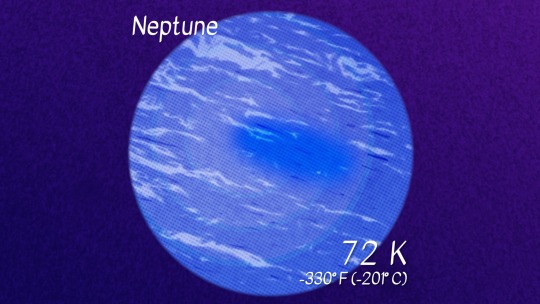
Credit: NASA's Goddard Space Flight Center/Scott Wiessinger
Let’s talk about some temperatures closer to home. Icy gas giant Neptune is the coldest major planet. It has an average temperature of 72 K at the height in its atmosphere where the pressure is equivalent to sea level on Earth. Explore how that compares to other objects in our solar system!

Credit: NASA's Goddard Space Flight Center/Scott Wiessinger
How about Earth? According to NOAA, Death Valley set the world’s surface air temperature record on July 10, 1913. This record of 330 K has yet to be broken — but recent heat waves have come close. (If you’re curious about the coldest temperature measured on Earth, that’d be 183.95 K (-128.6°F or -89.2°C) at Vostok Station, Antarctica, on July 21, 1983.)
We monitor Earth's global average temperature to understand how our planet is changing due to human activities. Last year, 2023, was the warmest year on our record, which stretches back to 1880.

Credit: NASA's Goddard Space Flight Center/Scott Wiessinger
The inside of our planet is even hotter. Earth’s inner core is a solid sphere made of iron and nickel that’s about 759 miles (1,221 kilometers) in radius. It reaches temperatures up to 5,600 K.

Credit: NASA's Goddard Space Flight Center/Scott Wiessinger
We might assume stars would be much hotter than our planet, but the surface of Rigel is only about twice the temperature of Earth’s core at 11,000 K. Rigel is a young, blue star in the constellation Orion, and one of the brightest stars in our night sky.
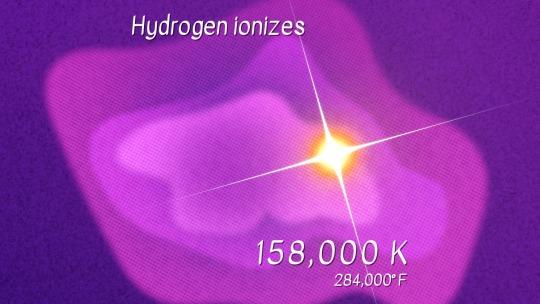
Credit: NASA's Goddard Space Flight Center/Scott Wiessinger
We study temperatures on large and small scales. The electrons in hydrogen, the most abundant element in the universe, can be stripped away from their atoms in a process called ionization at a temperature around 158,000 K. When these electrons join back up with ionized atoms, light is produced. Ionization is what makes some clouds of gas and dust, like the Orion Nebula, glow.

Credit: NASA's Goddard Space Flight Center/Scott Wiessinger
We already talked about the temperature on a star’s surface, but the material surrounding a star gets much, much hotter! Our Sun’s surface is about 5,800 K (10,000°F or 5,500°C), but the outermost layer of the solar atmosphere, called the corona, can reach millions of kelvins.
Our Parker Solar Probe became the first spacecraft to fly through the corona in 2021, helping us answer questions like why it is so much hotter than the Sun's surface. This is one of the mysteries of the Sun that solar scientists have been trying to figure out for years.

Credit: NASA's Goddard Space Flight Center/Scott Wiessinger
Looking for a hotter spot? Located about 240 million light-years away, the Perseus galaxy cluster contains thousands of galaxies. It’s surrounded by a vast cloud of gas heated up to tens of millions of kelvins that glows in X-ray light. Our telescopes found a giant wave rolling through this cluster’s hot gas, likely due to a smaller cluster grazing it billions of years ago.

Credit: NASA's Goddard Space Flight Center/Scott Wiessinger
Now things are really starting to heat up! When massive stars — ones with eight times the mass of our Sun or more — run out of fuel, they put on a show. On their way to becoming black holes or neutron stars, these stars will shed their outer layers in a supernova explosion. These layers can reach temperatures of 300 million K!

Credit: NASA's Goddard Space Flight Center/Jeremy Schnittman
We couldn’t explore cosmic temperatures without talking about black holes. When stuff gets too close to a black hole, it can become part of a hot, orbiting debris disk with a conical corona swirling above it. As the material churns, it heats up and emits light, making it glow. This hot environment, which can reach temperatures of a billion kelvins, helps us find and study black holes even though they don’t emit light themselves.
JAXA’s XRISM telescope, which we mentioned at the start of our tour, uses its supercool Resolve detector to explore the scorching conditions around these intriguing, extreme objects.

Credit: NASA's Goddard Space Flight Center/CI Lab
Our universe’s origins are even hotter. Just one second after the big bang, our tiny, baby universe consisted of an extremely hot — around 10 billion K — “soup” of light and particles. It had to cool for a few minutes before the first elements could form. The oldest light we can see, the cosmic microwave background, is from about 380,000 years after the big bang, and shows us the heat left over from these earlier moments.

Credit: NASA's Goddard Space Flight Center/Scott Wiessinger
We’ve ventured far in distance and time … but the final spot on our temperature adventure is back on Earth! Scientists use the Large Hadron Collider at CERN to smash teensy particles together at superspeeds to simulate the conditions of the early universe. In 2012, they generated a plasma that was over 5 trillion K, setting a world record for the highest human-made temperature.
Want this tour as a poster? You can download it here in a vertical or horizontal version!
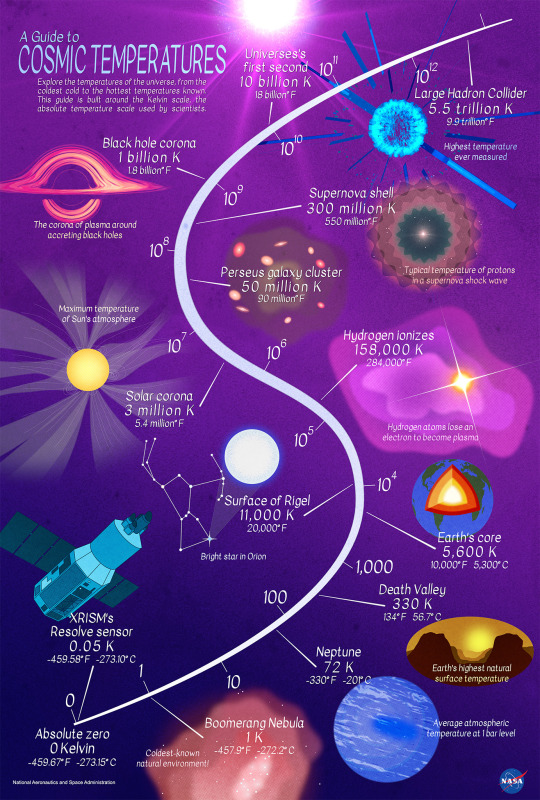
Credit: NASA's Goddard Space Flight Center/Scott Wiessinger
Explore the wonderful and weird cosmos with NASA Universe on X, Facebook, and Instagram. And make sure to follow us on Tumblr for your regular dose of space!
2K notes
·
View notes
Text

Watermelon growing at Russia's Vostok research station in Antarctica. © AARI
Russian Scientists Grow Watermelons 🍉 in Antarctica 🇦🇶
The researchers hope to eventually be able to grow other fruits and wild berries at all polar bases
Russian Polar Explorers have successfully grown a batch of watermelons at the Vostok Station in Antarctica, the Coldest Place on Earth, according to a statement published by the Arctic and Antarctic Research Institute (AARI).
“The results of the experiment are impressive – we managed to grow the southernmost watermelons in the most Severe Conditions of Antarctica,” said leading AARI Geophysicist Andrey Teplyakov, who led the project at the Vostok Station. “The taste and aroma are no worse than the ones we have at home! The size of the fruits is up to 13 cm in diameter, and their weight is up to 1 kg,” he said.
The experiment was a joint project between the AARI and the Agrophysical Research institute and the Institute of Biomedical Problems of the Russian Academy of Sciences.
In its statement, the AARI explained that favorable conditions for the plants, such as air temperature and humidity, were created by scientists with the help of a phytotechnical complex that was specially designed by the Agrophysical Institute for the Vostok Station.
“When growing plants, a thin-layer soil substitute, nutrient solutions and specially selected lighting were used. Two varieties of early ripening watermelons, which are able to adapt to low atmospheric pressure and oxygen deficiency, were planted in early April. The flowers were pollinated by hand at the end of May, and in July the polar explorers were able to taste the first fruits. The whole process took 103 days,” the statement reads.
AARI Director Aleksandr Makarov noted that aside from the scientific interest and practical benefits of having fresh vegetables, berries, and greens, the joint project had “a number of important additional advantages.”
“The greenhouse at the station has a positive effect on the emotional state of Polar Explorers,” Makarov said, noting that many of the researchers spend months in an isolated team, in conditions of polar night, low temperature and limited living space.
“Introducing the practice of growing plants at all Russian Polar Stations has been discussed for a long time, but this requires an accurate calculation of the effectiveness and cost of the project,” Makarov said.
The experiment dubbed ‘Plants’ was launched at Vostok in February 2020. Since then, the scientists have successfully worked out a system for growing 80 varieties of vegetables, including Tomatoes, Peppers, Dill, Spinach, Collard Greens, and others. The team’s next goal is to develop the technology for cultivating Blackberries, Blueberries, and Strawberries.
— RT | July 31st, 2023
#Watermelon 🍉#Antarctica 🇦🇶 | Russia 🇷🇺 | Russian Science#Agrophysical Institute for the Vostok Station#Atmospheric Pressure | Oxygen Deficiency#AARI Geophysicist Andrey Teplyakov#Tomatoes 🍅 | Peppers 🌶️ 🫑 | Dill | Spinach | Collard Greens 🥬#Blackberries | Blueberries 🫐 | Strawberries 🍓
0 notes
Text
Earth from the International Space Station

On April 12, 1961, astronaut Yuri Gagarin astounded the world by becoming the first person to travel to outer space. In less than two hours, Gagarin completed a full orbit of the Earth after launching the Vostok 3KA spacecraft. Less than a month later, Mercury astronaut Alan Shepard became the first American in space. The spectacle of looking back at Earth from space has not lost its charm, as you can see in this picture taken from the International Space Station. Well, our Mother Earth is a spectacle to behold, not only for those of us walking its grounds every day, but also for the ones who are lucky enough to look at it from a galaxy far, far away!
0 notes
Photo

European countries with research station on Antarctica
by geo.facts_
Out of the 29 countries with stations in the Antarctic continent, 16 of them are located in Europe and out of these 16 countries, 9 of them have more than two stations! Germany🇩🇪, Russia🇷🇺 and the United Kingdom🇬🇧 all have 5 stations on the continent, some of them working only during summer while others are permanently open.
As mentioned, some stations work only during summer, while others work all year long - meaning that the population of performing scientists and researchers varies from approximately 4.000 people during summer and only 1.000 during winter times (June to August).
Apart from that, there are several stations that don’t belong to any country, in other words, it means that they receive scientists from all over the world!
Fun fact: The coldest temperature ever registered on earth was at the Antarctic continent. In July 21 of 1983, at the Russian Vostok station, the thermometers recorded a temperature of -82.2C° (-115F°)
154 notes
·
View notes
Text
top five coldest places on the planet:
5. Dome Argus, Antarctic Plateau

Lowest recorded temperature: -82.5°C, July 2005
4. Amundsen-Scott South Pole Station, Antarctica

Lowest recorded temperature: -82.8°C, June 1982
3. Vostok Research Station, Antarctica

Lowest recorded temperature: -89.2°C, July 1983
2. Dome Fuji, Antarctica

Lowest recorded temperature: -93.2°C, August 2010
1. The Panera Bread Across the Parking Lot From My Job That I Stop At Nearly Daily After/During Work to Grab a Free Drink (I Am Signed Up For Panera's Sipsclub)

Lowest recorded temperature: undetectedable by current human technology
254 notes
·
View notes
Text

Hoax of the Day: Organism 46-B
Description: On November 30th, 2016, a story “broke” that when the Russian Vostok Station research team drilled into an underground lake in Antarctica, they discovered a man-eating creature simply called Organism 46-B. It is widely believed to be a fabricated story, meant for entertainment.
64 notes
·
View notes
Text
youtube
Hell Has Frozen Over
Vostok is a retro-inspired survival horror, inspired by Half-Life and John Carpenter's The Thing, with a twist. You are armed with a shotgun which you must operate manually.
Gameplay
Utilizing your wits and instinct, use your shotgun to navigate the abandoned Vostok Station, overrun by parasitic foes.
Manually control each aspect of the shotgun:
Load new rounds either by the ejection port or feeding ramp
Pump the shotgun by moving the mouse back and forth.
Mix and match different ammo types for unique shot combinations.
The only tool is your shotgun, so utilize it to your advantage against biohazardous foes.
Story
In 1957, you were apprehended by the Soviets and taken to Vostok Station, a remote research base in Antarctica. After lying in your holding cell, the door clicks open, revealing a ruined base infested with a parasitic entity that has taken control of the personnel. Armed with your shotgun and your will to survive, you have one task:
ESCAPE.
#indie games#gamedev#video games#half life#the thing#john carpenter#survival horror#low poly#horror#Youtube
8 notes
·
View notes
Text
Russian forces struck the infrastructure of Ukrainian military airfields, as well as drone assembly and storage facilities, the Ministry of Defense (MoD) reported.
The strikes also targeted concentrations of Ukrainian military personnel, equipment and foreign mercenaries in 163 areas, the MoD said.
The attacks were carried out using aviation, drones, missile forces and artillery.
Russian air defense systems also intercepted a French-made Hammer guided bomb, 14 US- made HIMARS rockets and 71 fixed-wing drones.
Other Developments
Russia's Tsentr Battlegroup repelled 12 counterattacks, inflicted up to 510 casualties and destroyed five armored vehicles, six motor vehicles and five howitzers while improving its positions across nine settlements in the Donetsk People's Republic.
Battlegroup Sever inflicted up to 45 casualties and destroyed an armored vehicle in the Kharkov Region near Volchansk.
Battlegroup Yug repelled two counterattacks, inflicted up to 245 casualties and destroyed three armored vehicles, five pickup trucks, a station for electronic warfare and an ammunition depot while improving positions near five settlements in the Donetsk People's Republic.
Battlegroup Vostok advanced into Ukrainian defenses, inflicted over 155 casualties and destroyed a tank, seven motor vehicles, five artillery systems (including one US-made M109 Paladin and one M198 howitzers) and an ammunition depot across six settlements in the Donetsk People's Republic and the Zaporozhye Region.
Battlegroup Zapad repelled six counterattacks, inflicted up to 480 casualties and destroyed a tank, three armored vehicles, three motor vehicles, three artillery systems, two electronic warfare stations, and five ammunition depots while improving positions near five settlements in Kharkov Region.
Battlegroup Dnepr inflicted up to 45 casualties and destroyed an armored vehicle, seven motor vehicles, four electronic warfare stations and two ammunition depots in the Zaporozhye and Kherson Regions.
4 notes
·
View notes
Text
I see a lot of people in the For All Mankind tag talking about how the pro-US propaganda is blatant and annoying. And it is, but I honestly don't think it could be made any other way and still be as grounded, which is a paradox but I think it's true.
For All Mankind is about the Space Race--its core concept/question is "What if the Space Race didn't end in 1969?" And the answer is, that if the Space Race hadn't ended, the massive propaganda machine built to propel it would keep going.
The entire concept of the Space Race was 100 percent organic, grass-fed Cold War propaganda, on both sides. My grandparents got married in Moscow the year Yuri Gagarin flew on Vostok 1; my dad watched Neil Armstrong take his first steps on the moon. Both were touted in their home nations as the height of human achievement and a mark of their nations' supremacy over their rival.
There's no way to convincingly depict the social climate of an extended Space Race without including a ton of propaganda. If you want to depict a more collaborative, less propagandistic timeline, that's the one we live in--an international space station (lowercase, not the same as the ISS) was proposed as a joint US/USSR collaboration as early as 1970. But unfortunately, the Cold War intensified in the 70s and because NASA was no longer a prominent fixture in the everyday American mind, politicians cut its funding.
For All Mankind actually depicts the friction between propaganda and reality pretty well, I think. They comment on the irony of the quote "We came in peace for all mankind" within the first episode, I think (currently don't have Apple TV so can't check) and, without going into detail, the show demonstrates throughout the decades how an atmosphere of propaganda and building to win damages international relations, public trust in science, and corrupts the very basis of why space exploration is so wonderful.
Just because they have space hotels and advanced technology does not mean that For All Mankind is meant to depict an ideal timeline or even a better timeline. It depicts a timeline where the goal is to win; not to explore, not to understand, and certainly not to collaborate. Most of the most inspiring real-world projects of the later 20th century aren't even considered important in the world of For All Mankind, just stepping stones to plant flags. If science does happen, it's a byproduct. If progress happens, it's in spite of the governments depicted, not because of it.
That's a world that's super interesting to watch, because it knows it needs the propaganda to move forward--and because it knows the propaganda is a lie.
#i almost called real life the 'canon timeline' i need to go to bed#for all mankind#it seems like they're planning on doing an iss thing but on mars in season 4 which should be interesting
18 notes
·
View notes
Text

Organism 46-B
Organism 46-B was an enormous 33ft (10m) long, 14-tentacled squid-like creature which lived in Lake Vostok, a subglacial lake located under two miles of ice beneath Vostok Station in the Antarctic. The animal had limbs that were animate and aggressive even after amputation, could release a toxin into the water to immobilize its prey from a distance of up to 150 feet, displayed an astonishing degree of shapeshifting, and showed a considerable degree of both hostility and intelligence.
Vostok Station, established by the Soviets in 1957, was discovered to have been sited atop a vast body of liquid water beneath the ice in 1974, which was subsequently named Lake Vostok after the station. After 30 years of ice core drilling, the research team finally breached through to the lake on the 5th of February 2012. This must have occurred sometime between then and the 30th November 2016 (when the story first broke), although exact dates have so far proven impossible to track down.
Dr. Anton Padalka claims to have been part of the first scientific expedition to explore the lake. “We encountered Organism 46-B on our first day. It disabled our radio - which we later learned, to our alarm, was intentional. It is also able to paralyze prey from a distance of up to 150 feet by releasing its venom into the water. Tragically my colleague and lifelong friend was killed this way."
Later, while diving in the lake, the group was attacked, the creature releasing its venom which took hold of one of them. The Organism then proceeded to kill and eat him. As Padalka stated "He tread water wearing a blissful smile as the organism approached him. We watched helplessly as it used its arms to tear off its head then popped its remains in its mouth. It was as if it had hypnotized him telepathically.”
Still, later, 46-B stalked the group, displaying its shapeshifting ability. "It shaped itself into the form of a human diver. We thought it was one of my colleagues swimming towards us in scuba gear. By the time the closest scientist had realized what it was, it had grabbed him and torn him to bits.”
Escaping the creature, a member of the team managed to lop off one of 46-B's tentacles, although the severed limb attacked the group again. "Later that night it slid across the ice bank and strangled her," stated Padalka.
After finally trapping the creature in a tank, the surviving members of the team brought it to the surface where they claim Russian officials seized the beast and told the international press that nothing had been found.
14 notes
·
View notes
Text

30 years NPP Zvezda... Since 1959, Soviet-Russian factory "Plant 918" was specialised in producing safety & rescue equipment for military pilots and cosmonauts. During the next 50 years, they successfully designed & produced space suits for the Vostok, Voskhod and Soyuz spaceflight programmes. In 1994, it was renamed NPP Zvezda (Research & Development Production enterprise Zvezda).
Most notable highlights were the Berkut "Eagle" space suit worn by Alexei Leonov during the first space walk (1965) and the modern-day semi-rigid Orlan space suit, used since December 1977 by both male & female cosmonauts. Even NASA astronauts, Jerry Linenger (1997) and Michael Barratt (2007), have used the Russian Orlan space suit during spacewalks. Anno 2024 seven different versions of the space suit have been used, with the latest Orlan-MKS having a capability to work up to ten hours outside the space station. Each of these space suits & space gloves have their own unique serial number and are a great collectors' item, which can even be used a wrist watch stand. Photo shows a 2007 Orlan-M space suit glove with 1997 Omega Speedmaster 1861 chronograph. (Photo: MoonwatchUniverse)
#861#chronograph#Omega#Speedmaster#Moonwatch#MoonwatchUniverse#Speedytuesday#NASA#ISS#spacesuit#spacewalk#Orlan#EVA#montres#uhren#horloges#pilot watch#Zulu time
6 notes
·
View notes
Note
★ for Jonathan, of course, (but also for Loki, if the thoughts are there, even though we haven't seen them in action :p)
Little Every Day Blessings || Accepting
Ku'u Kōheoheo || Jonathan Ionaka Crane

I like you // I love you // You’re my only real friend // You’re like family // You are family // I dislike you // I hate you // I’d kill you if I got the chance // I want you to like me // I’m scared of you // I would adopt you // I’d date you // I’d sleep with you // I’d marry you // I’m worried about you // You confuse me // You’re annoying // I pity you // I respect you // I trust you // I feel protective of you // I’d invite you with me to parties // I’d lend you my money // I’d borrow your money // Your eyes are winter morning in Vostok Station {but cold can burn deeper than fire} // I’m suspicious of you // I’m hiding something from you // You’re fun // You’re boring // I’m upset with you // You’re nice // You’re mean // I’m envious of you // You’re smart // You’re stupid // I look up to you // I think you’re a better person than me // I think I’m a better person than you // I want to apologize to you // I wish I’d never met you // I never want to forget you // I want to get to know you better // I kind of want to stab you with a fork.
~*~ The Bound God || Loki Laufeyson

I like // am sympathetic toward you // I love you // You’re one of my best friends // You’re like family // You are family // I dislike you // I hate you // I’d kill you if I got the chance // I want you to like me // I’m scared of you // I would adopt you // I’d date you // I’d sleep with you // I’d marry you // I’m worried about you // You confuse me // You’re annoying // I pity you // I respect you // I trust you // I feel protective of you // I’d invite you with me to parties // I’d lend you my money // I’d borrow your money // You’re beautiful // I’m suspicious of you // I’m hiding something from you // You’re fun // You’re boring // I’m upset with you // You’re nice // You’re mean // I’m envious of you // You’re smart // You’re stupid // I look up to you // I think you’re a better person than me // I think I’m a better person than you // I want to apologise to you // I wish I’d never met you // I never want to forget you // I want to get to know you better
#Mahalo!C <333#Persecuted and Paralysed|Ionaka and Beth#Ivy Grows Over the Door|University Era#Demons With Subtle Guile|Gotham au#All Our Tomorrows|DC#The Bound God|Loki Laufeyson#tbd|Loki and Beth#tbd|Verse#Golden Halls|Asgard
2 notes
·
View notes
Text
this is strictly for my own research and visualization purposes, anyway, what the US supplies antarctic researchers for their stuff, as summarized by this stack exchange thread https://earthscience.stackexchange.com/questions/3065/what-do-the-researchers-in-antarctica-wear-if-they-must-go-outside-during-winter am on my phone on the bus so no fancy in-text links for u.
this is bc my universe's heaven is a polar desert and has a climate comparable to antarctica, and while angels are a little more tolerant of cold temperatures than humans they still need to dress warmly. that being said; i am using what researchers wear bc tourists tend to stay in the north of antarctica where it's warmer
1 GOR-TEX wind jacket

1 helly hansen rain jacket
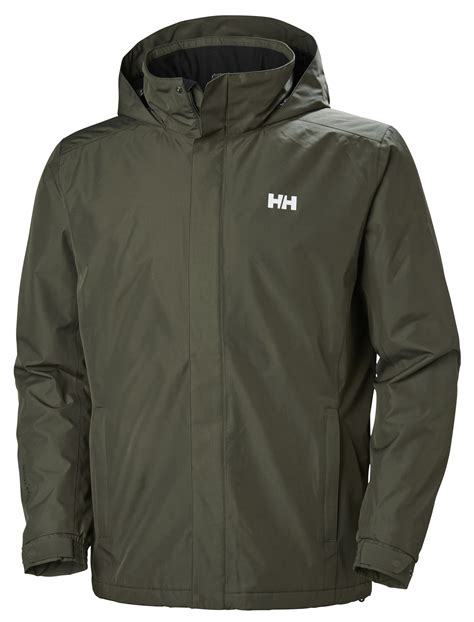
1 polar fleece jacket

1 carhartt jacket

1 carhartt vest

1 "big red" parka
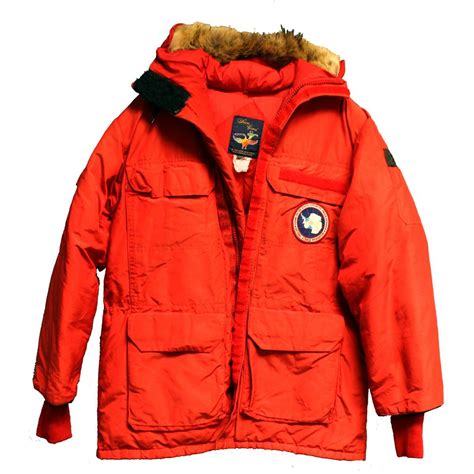
1 GOR-TEX bib coveralls
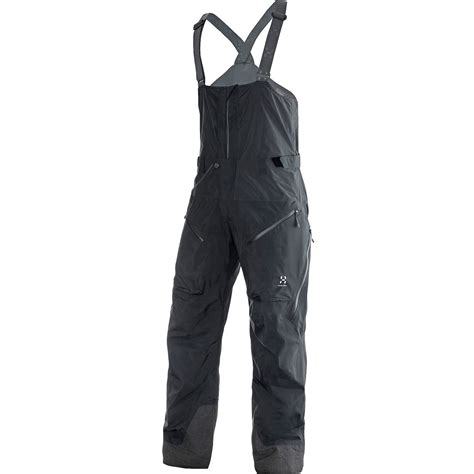
1 helly hansen rain pants

1 polar fleece pants (cozy)

1 carhartt bib overalls

gonna have to continue this bc the mobile app has an IMAGE LIMIT (bastards)
3 notes
·
View notes
Text
An interview with Eduard Skoryk, a rescue worker, member of the charity Vostok SOS. It is in English.
Since after the full-scale invasion, he has evacuated many people whose home became the frontline. On the day of the interview, he was helping an elderly disabled couple leave Toretsk (a town south of Bakhmut).
The material was published by the US radio station National Public Media on June 5th 2023 - a day before thousands more in the southern Ukraine came to need evacuation due to russia's genocidal destruction of Nova Kakhovka dam.
At the moment Vostok SOS is evacuating people whose homes were flooded in Kherson and Mykolaiv regions. At the same time, one of their teams continues working in Donetsk region: there is constant russian shelling and people need help there too.
To help, you can donate to Vostok SOS here (link to their site) and/or tell more people about their work.
#stand with ukraine#support ukraine#how to help#russian war against ukraine#russian war crimes#ukraine
13 notes
·
View notes
Text
🇷🇺🇺🇦 🚨 Report on the progress of the Special Military Operation according to the Ministry of Defense of the Russian Federation
Report by Press Centre Chief of Zapad Group of Forces
▫️ The Zapad Group of Forces continues to fulfil the combat missions within the special military operation in Kupyansk direction.
▫️ In the course of active defence, a motorised rifle unit of the Combined-Arms Army, supported by mortar fire, repelled a counterattack launched by assault groups of the AFU 57th Motorised Infantry Brigade near Liman Pervy.
▫️ Heavy flamethrower systems struck a cluster of troops in the shelters of the AFU 14th Mechanised Brigade near Sinkovka.
▫️ In addition, in the defence belt of the Combined-Arms Army, the unit's servicemen, supported by air and artillery fire, neutralised up to 20 servicemen, two BMP-1 infantry fighting vehicles, one BMP-2 IFV, one 152-mm 2S3 Akatsiya self-propelled artillery system, and two Humvee armoured fighting vehicles near Terny.
▫️ A Tor SAM system destroyed five unmanned aerial vehicles, including four Furia and one Leleka-100 UAVs close to Melovatka, Zhitlovka, Zaliman, and Petrovskoye.
🔹 Russian Defence Ministry
⚡️ Russian Defence Ministry report on the progress of the special military operation
(30 November 2023)
The Armed Forces of the Russian Federation continue the special military operation.
▫️ In Kupyansk direction, units of the Zapad Group of Forces supported by aviation and artillery repelled two attacks launched by assault detachments of the AFU 14th and 30th mechanised brigades near Sinkovka (Kharkov region). The enemy lost up to 45 Ukrainian troops and two motor vehicles.
▫️ In Krasny Liman direction, units of the Tsentr Group of Forces supported by helicopters repelled one attack launched by an assault detachment of the AFU 60th Mechanised Brigade near Yampolovka (Donetsk People's Republic).
The AFU losses amounted to up to 250 Ukrainian troops, two armoured fighting vehicles, and four motor vehicles.
▫️ In Donetsk direction, units of the Yug Group of Forces supported by aviation and artillery repelled two attacks launched by assault detachments of the AFU 79th Assault Brigade near Maryinka (Donetsk People's Republic).
In addition, strikes were delivered at manpower and hardware clusters of the AFU 93rd Mechanised Brigade near Andreyevka (Donetsk People's Republic). The enemy lost up to 270 Ukrainian troops, two armoured fighting vehicles, and three pickup trucks.
One U.S.-made AN/TPQ-37 counterbattery radar station was destroyed near Zhelannoye (Donetsk People's Republic).
▫️ In South Donetsk direction, units of the Vostok Group of Forces supported by aviation and artillery inflicted losses on manpower of the AFU 72nd Mechanised Brigade, 79th Airborne Brigade, and 58th Motorised Infantry Brigade near Novomikhailovka, Konstantinovka, and Novoukrainka (Donetsk People's Republic).
Up to 100 Ukrainian troops, one tank, two armoured fighting vehicles, and three motor vehicles were neutralised.
▫️ In Zaporozhye direction, units of the Russian Group of Forces supported by aviation and artillery repelled three attacks launched by assault detachments of the AFU 82nd Airborne Brigade and 71st Jaeger Brigade close to Verbovoye (Zaporozhye region).
In addition, strikes were delivered at manpower of the AFU 118th Mechanised Brigade, 46th Air Mobile Brigade, and 15th National Guard Brigade near Rabotino and north of Novopokrovka (Zaporozhye region).
The AFU losses amounted to up to 30 Ukrainian troops killed and wounded and three motor vehicles.
▫️ In Kherson direction, as a result of actions of the Russian Group of Forces supported by artillery and aviation, the AFU lost up to 55 Ukrainian troops and two motor vehicles.
Operational-tactical and Army Aviation, unmanned aerial vehicles, missile troops and artillery of the Group of Forces of the Armed Forces of the Russian Federation wiped out a rear command post of the AFU 53rd Mechanised Brigade, an artillery battalion command and observation post of the AFU 31st Mechanised Brigade near Krasnoarmeysk and Novogrodovka (Donetsk People's Republic), two CT-68UM and P-18 radar stations for detecting and tracking air targets, as well as manpower and military hardware in 118 areas.
Air defence units intercepted nine Ukrainian unmanned aerial vehicles near Tokarevka (Kharkov region), Lipovoye and Maryinka (Donetsk People's Republic), Pshenichnoye (Zaporozhye region), and Chaplinka (Kherson region).
📊 In total, 544 airplanes and 255 helicopters, 9,310 unmanned aerial vehicles, 442 air defence missile systems, 13,712 tanks and other armoured fighting vehicles, 1,187 combat vehicles equipped with MLRS, 7,205 field artillery guns and mortars, as well as 15,781 units of special military equipment have been destroyed during the special military operation.
🔹 Russian Defence Ministry
#source1
#source2
@WorkerSolidarityNews
#russo ukrainian war#russia ukraine crisis#russia ukraine today#russia ukraine conflict#russia ukraine war#russia#russia news#ukraine#ukraine war#special military operation#war#wars#war news#world news#global news#international news#international affairs#breaking news#current events#politics#geopolitics#eastern europe#eurasia#european news#europe news#russian military#news#WorkerSolidarityNews#military news#military
3 notes
·
View notes